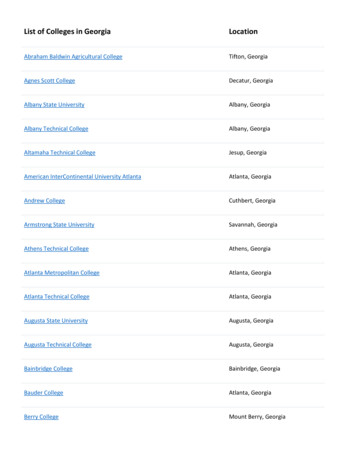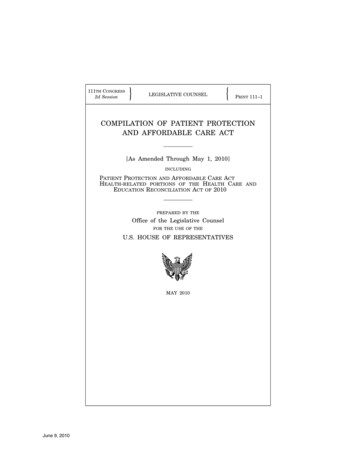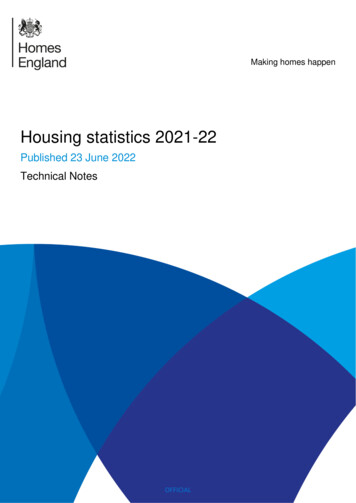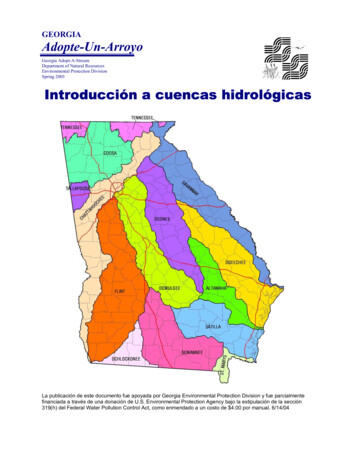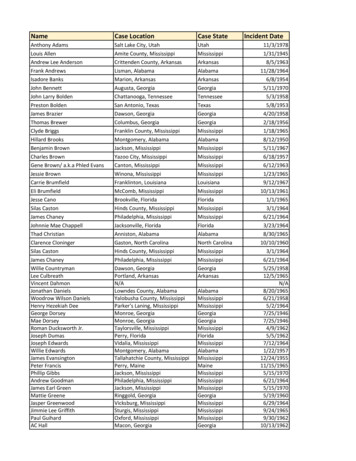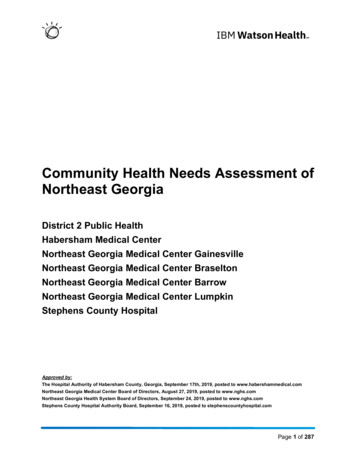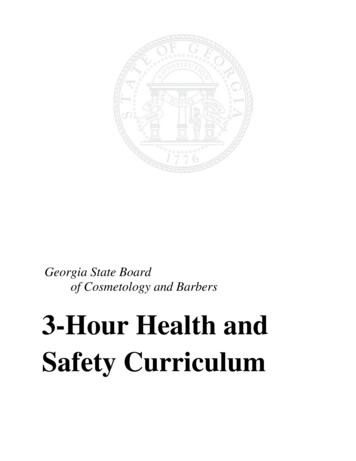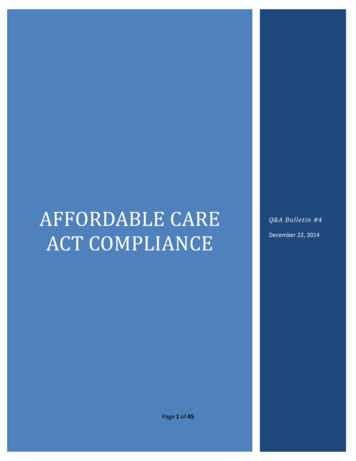
Transcription
AFFORDABLE CARE ACT COMPLIANCEQ & A Bulletin # 4 Dated 12/09/14AFFORDABLE CAREACT COMPLIANCEPage 1 of 45Q&A Bulletin #4December 22, 2014
AFFORDABLE CARE ACT COMPLIANCEQ & A Bulletin # 4 Dated 12/22/14Table of Contents (Click on the Sections/Questions below to access the specific page.)Welcome to the Georgia Department of Administrative Services Affordable Care Act (ACA) Q&A Bulletin! . 5Terms and Definitions . 6SECTION 1: GENERAL . 81) Is the Affordable Healthcare Act relevant to my agency?. 82) What has changed for employees? . 83) What has changed for employers? . 94) What happens if I do not offer healthcare coverage to a full-time employee? . 105) What are my specific responsibilities under the ACA as an HR Leader?. 106) What is the prescribed content of the ACA notice to employees? . 117) Can I provide notice of the healthcare exchange to employees electronically? . 118) What does it mean to use a Look-back/Measurement or Stability period? . 119) Will Georgia mandate a 29-hour workweek for hourly paid employees like other states, local governments, and privateemployers have done? . 1210) Will Georgia have a standard Look-back/measurement period? . 1211) Is an Administrative period required? . 1212) Does using the Look-back and administrative periods below mean that the state’s open enrollment period will beextended? . 1313) There are multiple time frames to consider. How are they related? . 1314) Should I manage new hires differently? . 1415) Does the ACA change the definition of a seasonal employee?. 1416) Should I manage rehires differently than new hires?. 1417) How do I manage employees hired in the middle of the standard Look-back/measurement period? . 1518) What should I be doing right now to ensure my agency is in compliance with the ACA? . 1619) Is the Stability period always the calendar year/plan year time frame of January – December?. 1620) How do we pay SHBP cost for hourly positions? . 1621) If the combined hours of an employee working for two state agencies meet the full-time threshold, is the employeeeligible for healthcare coverage? . 1722) If an employee works part-time at a state agency and a technical school, is the employee eligible for healthcare? Ifso, which entity should pay for coverage? If neither entity offers coverage which entity will pay the penalty?. 1723) Will employing agencies be required to pay the employer share of SHBP health coverage for ACA eligible temporary orother hourly employees? . 1724) What is the effective date of the employer premium? . 17Page 2 of 4512.22.14
AFFORDABLE CARE ACT COMPLIANCEQ & A Bulletin # 4 Dated 12/22/1425) How will an employing agency collect the employee’s portion of the premium if working hours have beensignificantly reduced during the stability period? . 17SECTION 2: Eligibility . 181) Should I offer healthcare enrollment to all employees to be safe? . 182) How can I identify all of my full-time employees?. 183) What is the overall process for using the Look-back and Stability periods? . 184) What is included in total working hours? . 195) Can non-state entities or entities that do not use PeopleSoft payroll use the public queries?. 206) If an hourly person is hired or determined to be eligible for coverage in the middle of the standard Look- back period,would they sign up for coverage at that time? . 207) What is the waiting period for any part-time employee once they have been deemed eligible for health benefit? . 208) What if we are hiring a person part time to work 30 hours per week, when would they become eligible?. 219) If an hourly person is hired or determined to be eligible for coverage in the middle of the standard Look- back period,would they sign up for coverage at that time?. 2110) What if we hire an employee to work six months and they work 30 hours a week? When do they become eligiblefor healthcare? . 2111) An hourly employee works full-time to cover for an employee who is out on long-term leave and who is expectedto be granted disability retirement. If the hourly employee is hired permanently, when will the employee becomeeligible for healthcare? . 2212) My agency hires employees on an hourly position for a 3-month probationary period. At the end of the probationaryperiod, some are moved to a full-time position, some are terminated, and some may be extended before a final hiringdecision is made. How does the ACA impact this program? . 2213) When must agencies offer healthcare to “hourly ” employees to comply with the ACA? . 22SECTION 3: REHIRED RETIREES . 231) How should I manage rehired retirees?. 232) Can a rehired retiree elect to have the employee portion of the healthcare premium continue to be deducted from theERS pension (because the rehired retiree chooses not to enroll in health coverage as an “active employee”)? And if so,would the hiring agency avoid responsibility for the employer portion of the premium? . 233) When a rehired retiree is entered into PeopleSoft/TeamWorks by the hiring agency, and the PeopleSoft code makesthe rehired retiree eligible for health coverage, what ADP/SHBP actions are generated by the entry? . 234) If a rehired retiree declines coverage as an “employee,” does the hiring agency avoid responsibility for the employerportion of the premium?. 245) What actions need to take place to reinstate coverage through ERS when an ACA eligible rehired retiree terminatesemployment? . 2412.22.14Page 3 of 45
AFFORDABLE CARE ACT COMPLIANCEQ & A Bulletin # 4 Dated 12/22/14SECTION 4: STAFFING AGENCIES / CONTRACTORS (1099) / INTERNS . 251)Can I hire independent contractors to avoid ACA requirements? . 252) Can I hire from a staffing agency to meet my variable hour or temporary employment needs and avoid ACApenalties? . 253)How do we handle temporary employees? . 264) Are students that rotate between school and their educational institution (co-ops) or interns in general eligible forhealthcare coverage? . 26SECTION 5: TECHNICAL--PEOPLESOFT DATA INPUT. 281) Once we have identified full-time employees eligible for healthcare coverage, how should we create the record in PSto show that they are eligible for flexible benefits or healthcare? . 282)Can we rely on the PS public queries to identify our healthcare eligible employees? . 283)Does “Hrly Emp Type” with “RGH” listed for all employees in the PS public query refer to “Regular Hours”? . 284)Does “Hourly Hours” mean the total number of hours worked? . 285)Does “Sum OT Hrs.” mean a summary of overtime hours worked? . 286)Should I add “Sum OT Hrs.” to “Hourly Hours” to determine total hours worked?. 287)Does “12 Month Avg per Week” reflect the average hours worked per week for the query period? . 288) If an ACA eligible temporary or other hourly employee does NOT enroll in SHBP coverage, should the employingagency still change the employee’s benefit program code to reflect eligibility? . 289) Do eligible temporary employees need to be on separate positions from non-eligible temporary employees forbudget projection and labor distribution purposes?. 29SECTION 6: REPORTING AND PENALTIES . 301)How will the IRS know an individual’s employer offered affordable healthcare? . 302)What happens if I do not offer healthcare coverage to a full-time employee? . 303)Should I just offer healthcare enrollment to all employees to avoid penalties? . 304)What will the exact penalty be if my agency doesn’t offer health insurance coverage to eligible employees? . 315)Are there penalties for non-compliance with the ACA reporting requirements? . 31Appendix: . 3212.22.14Page 4 of 45
AFFORDABLE CARE ACT COMPLIANCEQ & A Bulletin # 4 Dated 12/22/14Welcome to the Affordable Care Act (ACA) Q&A Bulletin!The Georgia Department of Administrative Services provides the ACA Q&A Bulletin to keep HR leaders in the State ofGeorgia Executive Branch agencies informed on evolving ACA requirements and to offer practical guidance about how tomanage their workforces to minimize related risks.We hope that you find this Bulletin helpful in obtaining answers to your questions efficiently. Each new Bulletin is anaccumulation of all previous ACA questions and answers. You do not need to keep prior versions.Topics within the below Sections have been updated and specific questions within each Section have been highlighted tohelp you quickly identify all new information:Section 1: GeneralOpen EnrollmentEmployer ContributionsEmployee premiumsSection 2: EligibilitySection 3: Rehired RetireesSection 5: Technical/PeopleSoft /Data InputYou may review the updates by scrolling through the document or you may click on the link on the Table of Contents pageto quickly identify only those questions and answers of interest. The Appendix contains all scenarios and decision trees forvisual demonstrations of situations described within the Bulletin.Although a determination has been made that the State Accounting Office will assist agencies utilizing Peoplesoft payrollwith a centralized reporting process, the State continues to work through details concerning how that process will work.Additionally, we are mindful that guidance concerning staffing agency labor and healthcare eligibility remains ambiguous.We continue to work with the IRS directly to obtain clarification about our obligation. Once we’ve obtained clarity on ournew obligations related to staffing agency personnel we will determine a system solution to effectuate that sub-process asnecessary.We understand there may be additional questions as you continue with compliance assessments, and there may beoperational issues that we have not yet contemplated. Please keep the lines of communication open by directing anyquestions to your assigned HRA consultant. If you do not know who your assigned HRA consultant is, please contact JacquiLindsay at 404-463-1284 or jacqui.lindsay@doas.ga.gov.12.22.14Page 5 of 45
AFFORDABLE CARE ACT COMPLIANCEQ & A Bulletin # 4 Dated 12/22/14Terms and DefinitionsThe terms below are defined by the ACA Final Regulations and should be applied in all situations involving compliance withthe ACA.TERMSADMINISTRATIVE PERIODFULL-TIME EMPLOYEESFULL-TIME EQUIVALENTEMPLOYEESLOOK BACK/MEASURMENT PERIOD12.22.14DEFINITIONSThe ACA defines the term administrative period as an optional period, selected by anapplicable large employer member, of no longer than ninety (90) days beginning immediatelyfollowing the end of a measurement period and ending immediately before the start of theassociated stability period. The administrative period is intended to allow time to providenotice to employees of eligibility changes, to offer health coverage, and for employees to enrollin healthcare. The administrative period also includes the period between a new employee’sstart date and the beginning of the initial measurement period, if the initial measurementperiod does not begin on the employee’s start date.A full time employee is an employee working thirty (30) hours a week on average in one month,unless an employer uses a measurement period, then a full-time employee is an employee withwork hours of thirty (30) hours a week on average during a measurement period.Generally in determining whether an employer is an applicable large employer, the number offull time equivalent employees (FTEs) it employed during the preceding calendar year is takeninto account. All employees (including seasonal workers) who were not employed on average atleast thirty (30) hours of service per week for a calendar month in the preceding calendar yearare included in calculating the employer’s fulltime equivalent employees for that calendarmonth. To determine the number of FTEs for a particular month, the employer must add up thenumber of hours of service for all employees who were not employed for at least 30 hours onaverage per week for that month, then divide that number by 120. The result is the number ofFTEs for that calendar month. All fractions are disregarded (for example, 49.5 full-timeemployees (Including FTEs) for preceding calendar year would be rounded to 49 employees).A look-back / measurement period is a period of time allowed under the ACA for an employerto determine whether an employee is considered a full time employee for purposes of the ACA.During the look-back / measurement period the employer monitoring the employee’s hours ofservice for a period of time. At the end of the look-back / measurement period, the employerwill average the employee’s number of hours of service during that time period. This averagewill be used to determine whether the employee should be offered healthcare coverage. TheState of Georgia will be using a 12 month standard look-back / measurement period. Note: The final regulations authorize large employers to use a look-back/measurementperiod for variable hour and seasonal employees to test their eligibility for healthcare.Therefore, the State’s “hourly” employees that meet the definition of variable hour orseasonal employees (see definitions above) do not become immediately eligible toenroll in healthcare within 3 calendar months as other new employees do, evenknowing they will work 30 or more hours per week for the season. This outcomeresults from using a 12 month look-back/measurement period which will most likelyaverage the seasonal worker’s hours as being less than 30 hours per week over themeasurement period.Page 6 of 45
PARITY RULE EXEPTIONPART-TIMESEASONAL EMPLOYEESSTABILITY PERIODVARIABLE HOUREMPLOYEE12.22.14AFFORDABLE CARE ACT COMPLIANCEQ & A Bulletin # 4 Dated 12/22/14Employees with a break in service of less than 13 weeks may still qualify as a new hire if theindividual's break in service was more than 4 weeks, and the break in service was longer induration than the last employment period.A part-time employee is an employee reasonably expected to work less than thirty (30) onaverage during a measurement period. Note: There is no general definition for a temporary employee. The IRS refers tovarious temporary employment arrangements as “short-term” and has acknowledgeconsideration of whether they should issue further guidance regarding “short-term”employment arrangements. Unless and until the IRS issues such guidance, the mostimportant change brought about by the ACA that you must understand is thathealthcare eligibility is not tied to duration of employment, but to the number of hoursan employee is anticipated to work weekly on average at the time of hire. There aretwo exceptions – variable hour or seasonal employment.The ACA defines seasonal employee in two ways:1) First in the context of determining whether you are a large employer subject to theemployer mandate provision of the ACA. See also Question 17 below. Employers withemployees that work 120 or fewer days a year may subtract this number from theirworkforce count, if the employer is a large employer due only to seasonal employees.2) The ACA provides a second definition of a seasonal employee for purposes ofeligibility. In this context, seasonal employees are defined as those that typically worksix months or less, and whose work begins at approximately the same time each year,such as winter or summer. In some instances, the employee may still be consideredseasonal even if the seasonal employment period is extended in a particular yearbeyond its customary duration (regardless of whether the customary duration is sixmonths or less than six months). An example of such an instance would be a skiinstructor with a period of employment with a customary duration of six months,working a seventh month in a particular year due to an unusually long snow season. Note on change in employment status for seasonal employees:The final regulations provide that if a seasonal employee experiences a change inemployment status before the end of the initial measurement / look back period thattransfers the seasonal employee into a permanent, full time (working 30 or morehours per week) position, the employer has to offer insurance within three calendarmonths following the change in employment status OR if the employee averaged 30hours or more during the measurement / look back period, by the first day after theend of the initial measurement period’s administrative period, whichever is shorter.Under the ACA, the term stability period means a period selected by an applicable largeemployer member that immediately follows, and is associated with, a standard look back /measurement period (and, if elected by the employer, the administrative period associatedwith that standard measurement period or initial measurement period). The Stability period isthe period for which an employee’s eligibility status is “locked” in. It must at a minimum be aslong as the look-back / measurement period. Thus, if an employee is determined to behealthcare eligible using a 12 month look back / measurement period, then the employee mustreceive healthcare coverage for the 12 months following the administrative period – regardlessof whether the employee’s hours fall below the 30 hour a week average during the stabilityperiod.A new hire is a variable hour employee if at the time of hire you do not know whether theemployee will work 30 hours a week on average, or you reasonably believe the employee willwork 30 or more hours a week on average for a short period of time only, then work less than30-hour weeks.Page 7 of 45
SECTION 1: GENERALAFFORDABLE CARE ACT COMPLIANCEQ & A Bulletin # 4 Dated 12/22/141) Is the Affordable Healthcare Act relevant to my agency?Most likely. The ACA requires employers with 50 or more full-time or full-time equivalent employees (referred to as alarge employer) to offer full-time employees affordable healthcare coverage. A full-time employee is someone that works30 hours or more a week on average in any month, or someone that works 130 hours in one calendar month.For this initial threshold question about whether you are a large employer for purposes of the ACA, you will look at theprior calendar year, count full-time employees (using the ACA definition of at least 30 weekly hours, or the equivalent forsalaried employees), pro-rate employees working less than 30 weekly hours to determine full-time equivalents, andexclude seasonal employees working 120 or fewer days from the count. Calculate the total for all business days in eachmonth to derive your agency’s average headcount for the year. If your agency operates 24/7 all days of the week arebusiness days for you.Example 1: Agency with 30 FLSA-exempt and nonexempt employees working 40 hours a week, 10 part-time employeesworking 20 hours a week, and 15 additional non-seasonal “hourly” employees working 30 or more hours a week has aworkforce count of 51 full-time and full-time equivalent employees. (Calculation: 30 15 full-time employees 10part-time employees X 80hrs 800 aggregate hrs. / 120 monthly full-time hrs. 6 full-time equivalents 51 totalemployees. Note: That by dividing by 120, just the first 120 hours of non-full-time employees count. Agency is a largeemployer subject to the ACA.Example 2: Agency with 30 FLSA-exempt and nonexempt employees working 40 hours a week, 15 non-seasonal“hourly” employees working 30 or more hours weekly, and 25 seasonal employees working 30 or more hours weekly fora short period has a workforce count of 45 for most of the year. (Calculation: 30 15 45 total employees). Agency is nota large employer subject to the ACA. Because agency only becomes a large employer seasonally, employer may excludeseasonal employees from the count and will not be subject to ACA penalties.Based on workforce totals in PeopleSoft, the ACA may impact all but five state employers. Please note that the answer inthis question assumes each state agency is an individual employer, which is not addressed within the ACA for public sectorentities and remains an open question. The DOAS HRA Division will work with the Attorney General's Office to determineif or when this interpretation should be modified.2) What has changed for employees?Effective January 2014 all individuals (with limited exceptions) must purchase health insurance after a 90-day graceperiod or pay a penalty of 95 or up to 1% of income, whichever is greater, progressing to 695 or up to 2.5% of incomeby 2016. If employees are not offered affordable health insurance through their employer, they may seek to purchasecoverage through the federal healthcare exchange and may be eligible to receive a federal tax subsidy to offset premiumand certain out of pocket costs.12.22.14Page 8 of 45
AFFORDABLE CARE ACT COMPLIANCEQ & A Bulletin # 4 Dated 12/22/14Open enrollment for the exchange begins October 1 and continues through March 31, 2014. Open Enrollment for thefederal exchange has been delayed for coverage in 2015 and will now run November 15, 2014 – January 15, 2015. Openenrollment for plan years subsequent to 2015 is currently planned to begin October 1 and end January 15.Therefore, eligible employees not offered health insurance through the State Health Benefit Plan will have ample timebeyond the State's open enrollment period to determine eligibility through the healthcare exchange.Individuals without healthcare coverage when filing income taxes in 2015 for 2014 will be assessed a fee. There areexceptions and exemptions which employees must coordinate on their own with the IRS, along with specific rulesgoverning coverage for dependents. Precisely how the IRS plans to consolidate ACA-related information from thevarious reporting sources remains unclear at this time.State agencies are not responsible for assisting employees with healthcare exchange eligibility and enrollment questionsand should avoid providing tax advice to employees. Because employees will likely turn to their HR departments withquestions, we have included two federally sponsored online resources. Employees may visit the federal insuranceexchange website at HealthCare.gov to learn more or join a chat room, or call the exchange customer service callcenter at 1-800-318-2596.3) What has changed for employers?Prior to the ACA, employers rather than the Fair Labor Standards Act or Georgia state law defined full-time employment orworking hour limits for adult employees. The ACA now defines a full-time employee as someone employed for 30 hours ormore per week on average in any month. This definition requires agencies to track each employee's full-time statusmonthly. Alternatively, agencies may retrospectively average hours worked or paid over a longer period of time to projectan employee's future full-time status by using the IRS method of Look-back and Stability periods. This method allowsagencies to test for full-time status before extending healthcare benefits to employees who may appear to meet thethreshold.Historically, the State has not determined benefit eligibility based solely on the number of hours worked, but rather onworking hours and whether the type of employment relationship was deemed temporary or non-temporary. The Statehas a number of employment relationships deemed temporary that are not eligible for benefits: temporary; timelimited; seasonal; casual; and interns. With few exceptions, individuals in these positions are hired with an establishedend-date of 9 months or sooner. Casual employees work on-call and intermittently as needed. Agencies refer to thesetypes of employment relations in the aggregate as “hourly” due to the manner in which wages are calculated. Undercurrent practice, “hourly” employees are not benefit-eligible because they do not meet the two threshold criteria ofhours wor
Welcome to the Affordable Care Act (ACA) Q&A Bulletin! The Georgia Department of Administrative Services provides the ACA Q&A Bulletin to keep HR leaders in the State of Georgia Executive Branch agencies informed on evolving ACA requirements and to offer practical guidance about how to manage their workforce s to minimize related risks.
